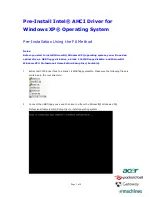
18
EPICenter Concepts and Solutions Guide
EPICenter Overview
Finally, from a managed device node on the map, you can invoke other EPICenter functions such as the
alarm browser, telnet, real-time statistics, a front panel view, the VLAN Manager, or ExtremeWare Vista
for the selected device.
Enterprise-wide VLAN Management
A virtual LAN (VLAN) is a group of location- and topology-independent devices that communicate as
if they were on the same physical local area network (LAN).
The EPICenter VLAN Manager is an enterprise-wide application that manages many aspects of VLANs
on Extreme Network’s Summit, BlackDiamond, and Alpine switches. Any EPICenter user can view
status information about the VLANs known to EPICenter across the network. Users with the
appropriate access can create and delete VLANs, add and remove ports from existing VLANs, and
create and modify the protocol filters used to filter VLAN traffic. When creating or modifying a VLAN,
you can get EPICenter to determine whether there is connectivity between the devices you have
included in the VLAN, and if not, it can recommend what ports and devices you should add to achieve
connectivity.
The ESRP Manager
The Extreme Standby Router Protocol (ESRP) is a feature of ExtremeWare that allows multiple switches
to provide redundant layer 3 routing services, as well as layer 2 redundancy, to users. The ESRP
Manager displays the status of ESRP-enabled VLANs and the ESRP-enabled switches in those VLANs.
You can view a summary status for all the ESRP-enabled VLANs being monitored by the EPICenter
software. You can also view detailed information for an individual ESRP-enabled VLAN and the
switches in those VLANs.
The STP Monitor
The EPICenter Spanning Tree Protocol (STP) Monitor module displays information about STP domains
network-wide at the domain, VLAN, device, and port levels. The STP Monitor can monitor STP
domains configured on devices running ExtremeWare 6.2.2 or later. Earlier versions of ExtremeWare
supported the Spanning Tree protocol, but STP information via SNMP (required for EPICenter) is
available only with ExtremeWare version 6.2.2 or later.
EPICenter Reports
EPICenter Reports are HTML pages that can be accessed separately from the main EPICenter user
interface, without logging in to the full EPICenter client. EPICenter reports do not require Java, so
reports can be loaded quickly, even over a dial-up connection, and can be viewed on systems that
cannot run the browser-based or installed EPICenter clients. Reports can be printed using the browser
print function.
The Reports capability provides a large number of predefined HTML reports that present a variety of
types of information from the EPICenter database. You can also create your own reports by writing Tcl
scripts. Further, within the Reports Module are several useful tools such as a MIB Browser and other
tools that can provide EPICenter system information.
The Reports module can also be accessed from the Navigation toolbar within the EPICenter client
application. A Summary report is displayed on the EPICenter Home page that provides basic
information on the status of EPICenter devices and alarms. From this report you can access other more
detailed reports.
Summary of Contents for EPICenter 5.0
Page 12: ...12 EPICenter Concepts and Solutions Guide Preface...
Page 76: ...76 EPICenter Concepts and Solutions Guide Managing your Network Assets...
Page 92: ...92 EPICenter Concepts and Solutions Guide Managing VLANs...
Page 116: ...116 EPICenter Concepts and Solutions Guide Managing Wireless Networks...
Page 146: ...146 EPICenter Concepts and Solutions Guide VoIP and EPICenter Avaya Integrated Management...
Page 163: ...Appendices...
Page 164: ......
Page 178: ...178 EPICenter Concepts and Solutions Guide Troubleshooting...
















































